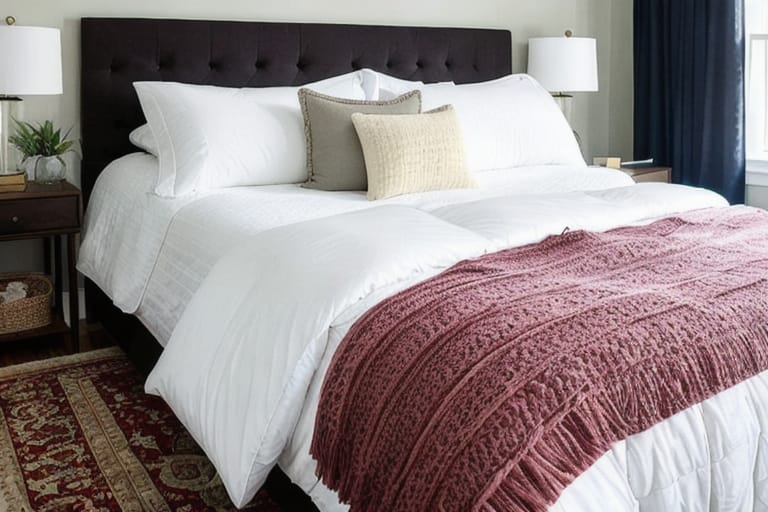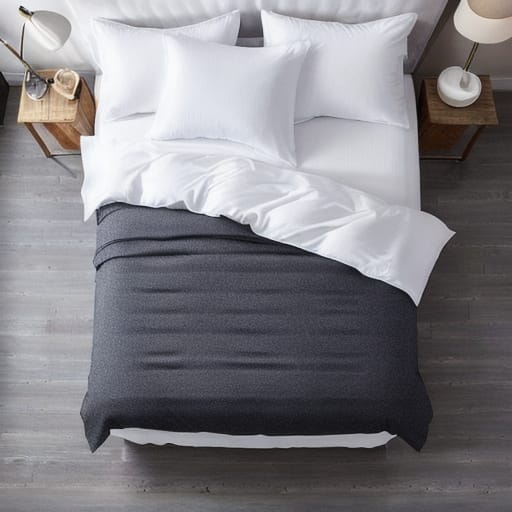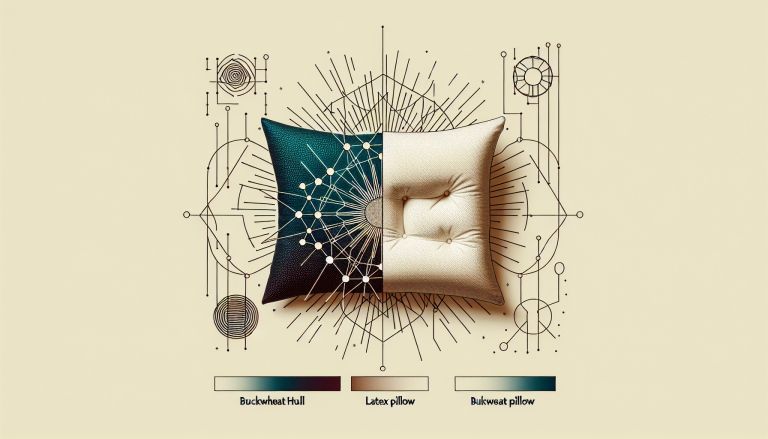Down duvets provide unparalleled warmth and comfort for your bed. With origins tracing back centuries, down fill remains the gold standard for luxury bedding across the globe.
This beginner’s guide will teach you everything you need to know about down duvets. You’ll learn how they are ethically sourced and manufactured while providing optimal thermal insulation. We’ll compare the pros and cons of down versus synthetic duvets and outline key factors in choosing the best down duvet for your personal needs.
Whether you’re looking to invest in your first down-filled bedding or replace an old duvet, use this guide to become an informed shopper. Let’s get started!
What is Down?
Before purchasing any down-filled product, it helps to understand precisely what down is.
- Down refers to the soft, fluffy clusters that sit underneath the outer feathers of ducks and geese. This specialized plumage works to insulate birds against cold weather and water.
- This natural fill provides unmatched loft, warmth and comfort – making it perfect for duvets and pillows.
- Goose down clusters tend to be larger and more resilient than duck down. This results in increased durability and better insulation.
- All down used in commercial bedding today comes as a by-product of the food industry. No live plucking takes place.
The Difference Between Down and Feathers
While the terms down and feather are sometimes used interchangeably, they make up distinct plumage layers:
- Down – The soft, fluffy undercoating closest to a bird’s skin providing insulation
- Feathers – The longer, more rigid exterior feathers providing structure and allowing flight
Why Choose a Down Duvet?

Down-filled duvets provide unmatched advantages over synthetic alternatives:
- Superior Warmth – Down offers the highest warmth-to-weight ratio of any duvet fill material. The clusters trap air to retain heat.
- Lightweight – Lofty down fill provides warmth without weight, easing strain on your body.
- Breathability – Air circulates freely through down, preventing overheating while you sleep.
- Durability – With proper care, a high-quality down duvet will last over 10 years.
- Luxury – Down offers a sensory experience with its cloud-like softness and billowy comfort.
“Of all insulating materials, down provides the most warmth and comfort for its weight and thickness.” – Outdoor Gear Lab
Down Fill Power Explained
The fill power denotes the insulating capacity and quality of down material inside a duvet.
Higher fill powers correlate with increased warmth and durability. They also come with a higher price tag. When purchasing a down duvet, you typically want a minimum fill power of 600. Popular ranges include:
- 600-650 – Entry level quality with decent insulation
- 700-800 – Mid-range with reliable performance
- 800+ – Premium down with exceptional loft and longevity
The highest quality down duvets use Hungarian white goose down exceeding 900 fill power.
Ethical Sourcing Matters
With down duvets, always look for third-party certifications to ensure ethical sourcing practices. Leading agencies include:
Responsible Down Standard (RDS)
- Confirms no live-plucking or force-feeding
- Sets standards for animal welfare
DOWNMARK®
- Validates and traces supply chains
- Verifies sanitization for quality
Reputable manufacturers only use traceable down certified under the RDS, DOWNMARK® or similar standards. This protects both the birds and your health.
Down vs. Down-Alternative Duvets
For those with dust mite allergies or seeking vegan bedding, synthetic fills provide viable down alternatives:
| Type | Pros | Cons |
|---|---|---|
| Cotton | Breathable, machine washable | Clumping, heavy, less warmth |
| Bamboo | Moisture-wicking, eco-friendly | Prone to shifting |
| Silk | Lightweight, hypoallergenic | Expensive, delicate |
| Microgel | Moldable support, hypoallergenic | Retains heat, synthetic feel |
While advancements improve continuously, no synthetics fully match the comfort and insulation of quality goose down yet.
Construction Impacts Performance
Down duvets come in two common construction types:
Box Stitch Duvets
This traditional construction joins the shell fabric and down fill together inside repeating square patterns:
- Advantages: Maximizes loft, easier to wash
- Disadvantages: Heavier, down shifting risk
Channel Stitch Duvets
This method uses narrow sewn channels to divide fill into segments:
- Advantages: Lighter, down stays evenly distributed
- Disadvantages: Lower height, can trap heat
Shell Fabric Matters Too!
A duvet’s outer shell impacts comfort, durability and pricing. Luxury down duvets use premium weaves like:
- Sateen Cotton – Silky soft, breathable, durable luxury
- Percale Cotton – Lightweight, breathable, crisp feel
- Silk – Ultra lightweight, moisture-wicking luxury
- Egyptian Cotton – Most exclusive cotton with extra-long fibers
Always choose a shell fabric with a tight weave to prevent fill leakage over time.
How Much Fill Do You Need?
The fill weight denotes how much down actually goes inside your duvet. This generally ranges from 300 gsm to 1200 gsm.
Heavier weights provide more insulation and durability:
- Lightweight (300-400 gsm) – Warm enough for summer or hot climates
- All-season (600-800 gsm) – Provides comfort across varying temperatures
- Extra warmth (900+ gsm) – Ideal for cold winters and frigid environments
Consider your climate and room temperature preferences when deciding.
Reading the Tog Rating
The tog rating indicates the warmth level provided by a duvet. Most quality down duvets fall between 7 tog and 13.5 tog.
General tog rating guidelines:
- 7-10 tog – Ideal for summer, transitional seasons
- 10.5-13.5 tog – Recommended for colder weather and winter
- 15+ tog – Extra insulation needed for freezing conditions
Select a tog rating suitable for your climate and sleeping preferences. Those who run cold at night may prefer higher ratings.
Top 5 Luxury Down Duvet Brands

Investing in a premium down duvet ensures the highest quality materials and craftsmanship. Based on testing and reviews, top luxury brands include:
- Snowe (800 fill power) – Hotel-style from $465
- Brooklinen (700 fill power) – Minimalist from $349
- Buffy (700 fill power) – Eco-friendly from $249
- Parachute (750 fill power) – Roomy sateen from $349
- Boll & Branch (500 fill power) – Classic organic from $398
For even higher fill powers, custom Hungarian goose down duvets from Cuddledown deliver unmatched quality and performance.
Caring for Your Investment
To extend your down duvet’s lifespan for over a decade, follow these care instructions:
- Dry Clean Only – Have professionally cleaned once every 2-3 years
- Ventilate Regularly – Air out down to retain loft
- Low Heat Drying – Tumble dry low to redistribute fill
- ** Wool Dryer Balls** – Use dryer balls to separate clumps
- Light Storage – Store in breathable bag in low humidity
With proper maintenance techniques, a quality down duvet should last 10-15 years or longer.
Ready to Find Your Perfect Duvet?
We hope this beginner’s guide provided you with a helpful education on down bedding basics. From ethical sourcing to construction methods, you now understand what makes an exceptional down duvet.
Use the buying criteria and recommendations above to find the ideal down duvet catering to your climate, sleep preferences and budget.
Sweet dreams!
Frequently Asked Questions
Still have some questions about down duvets? Check out these commonly asked FAQs:
What is fill power and why does it matter?
Fill power measures the loft and insulating capacity of down fill. Higher fill powers like 700-900+ provide exceptional warmth and durability. Premium Hungarian goose down can exceed 900 fill power.
How is down ethically sourced?
Reputable brands only use traceable down certified under the Responsible Down Standard (RDS) or similar. This guarantees no live-plucking or force-feeding with standards for animal welfare. Certifications like DOWNMARK® also verify ethical supply chains.
What’s better for allergies: down or down-alternative duvets?
For allergy sufferers, down-alternative duvets with hypoallergenic bamboo, silk or microgel synthetic fills provide viable options. However, quality down also resists dust mites. NOMITE certification guarantees strict standards for cleaning and maximum hygiene.
How do I choose the right tog rating?
The tog rating indicates the warmth level of a duvet. Choose 7-10 tog for summer and hot climates. Opt for 10.5-13.5 tog for colder weather and winter. 15+ tog provides extra insulation for freezing conditions. Also consider your typical sleep temperature.
What is fill weight and how much do I need?
Measured in grams per square meter (gsm), fill weight denotes the down density inside your duvet. Lightweight fill around 300 gsm works well for summer while 900+ gsm provides extra warmth for winter. Pick an all-season weight around 600-800 gsm for use across varying temperatures.
How often should I wash my down duvet?
Only dry clean your down duvet once every 2-3 years to retain maximum loft and extend its lifespan. More frequent washing will damage down clusters. Air out the duvet regularly and use wool dryer balls in the dryer instead to redistribute fill after use.
What type of shell fabric is best?
Look for tightly-woven sateen cotton or percale cotton shells. Silk and Egyptian cotton offer ultra-luxurious options. Avoid shells prone to down leakage. High thread counts improve breathability and comfort against skin. Durable fabrics also withstand repeated use.








